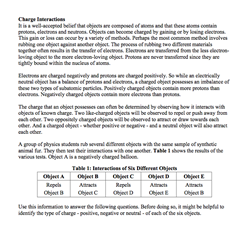 Charge Interactions
Charge Interactions
Resource:
Science Reasoning Center: Charge Interactions
Grade Level: High School
Description:
This passage provides background information regarding charge and charging methods and then describes an experiment in which various objects are charged by rubbing with animal fur. Information regarding their attractive and repulsive interactions is provided in the form of a data table. Questions target a student's ability to retrieve information from a body of text, to understand the design of an experiment, to draw conclusions that are consistent with observations, to make predictions based on a model, to identify the supporting evidence for a particular conclusion, and to predict the results of an additional trial in an experiment.
Performance Expectation:
HS-PS1-3 Plan and conduct an investigation to gather evidence to compare the structure of substances at the bulk scale to infer the strength of electrical forces between particles.
This activity aligns with the three dimensions of the Next Generation Science Standards in the manner described below:
| Types of Interactions (HS-PS2.B.3): Attraction and repulsion between electric charges at the atomic scale explain the structure, properties, and transformations of matter, as well as the contact forces between material objects. |
This passage explores how electrical forces between objects at the ‘everyday scale’ are due to an imbalance of protons and electrons at the atomic scale. In the data presentation, students consider how each of five objects interact with each other. Based on these visible observations, students are asked to use the atomic model described at the beginning of the passage to infer characteristics about the objects at a scale that they are not able to see. |
| Patterns: Different patterns may be observed at each of the scales at which a system is studied and can provide evidence for causality in explanations of phenomena. |
Electrical interactions (attraction and repulsion) viewed at the macroscopic scale are the only thing students can ‘see’ in this data presentation. As students explore patterns in the data, however, they are able to make claims about each object at a scale much smaller than can be studied by the eye. Students are asked to provide explanations as to why these objects behave in the manner that they do. |
| Cause and Effect: Cause and effect relationships can be suggested and predicted for natural and designed systems by examining what is known about smaller-scale mechanisms within the system. |
After reading a brief body of text about charging and charging methods, students explore how rubbing some objects makes them repel a particular object while rubbing other objects makes them attract. By examining what is known about the electrical interactions at the atomic scale, students are asked to hypothesize what must have occurred at this scale to cause these results to be observed. |
| Developing and Using Models: Develop or use a model based on evidence to illustrate the relationships between systems or between components of a system. |
Scientists find atomic models so valuable in understanding the branch of physics known as electrostatics. This passage requires students to uses an atomic model to explain the electric interactions between objects. |
| Constructing Explanations and Designing Solutions: Apply scientific principles and evidence to provide an explanation of phenomena and solve design problems, taking into account possible unanticipated effects. |
As students are asked to construct explanations for the observed phenomena, they use the scientific principle that opposite changes attract and that likes repel as a basis for their reasoning. In other instances, some questions at the end of the passage ask students to use evidence from the observed data to predict how and explain why new objects will interact when they are brought near the objects considered in the original data presentation. |
| Engaging in Argument from Evidence: Make and defend a claim based on evidence about the natural world that reflects scientific knowledge, and student-generated evidence. |
Nearly half the questions at the close of this passage require students to make and defend a claim about the net charge of an object or the relative number of protons and electrons within that object. The responses from which student must choose requires their claim to be supported with evidence from the results shown in the table. |
| Obtaining, Evaluating, and Communicating Information: Critically read scientific literature adapted for classroom use to determine central ideas and obtain scientific/technical information. |
Questions 1 and 5 in this passage require the reader to obtain information from a brief body of text and to use this as part of their explanation of a given phenomenon. As applying this scientific information must be combined with the data presented in order to explain the attraction and repulsion of various objects, the student must obtain and evaluate this information carefully as he or she reads the passage. |
Associated Reading from The Physics Classroom
Other Supporting Pages at The Physics Classroom:
View Infographic.
(Coming Soon)
Search the NGSS Corner
Maybe you're looking for something really specific that pertains to a desired topic and emphasizes one or more of the listed NGSS dimensions. Why not try a search of this section of our website? Simply select from one or more of the pull-down menus and click Search This page will reload and a collection of possibilities will be displayed in this section of the page and sorted by relevancy.